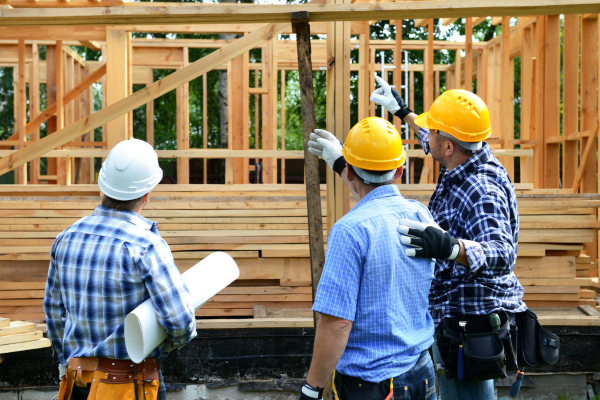.png)
From Bricks to Drones: The Robotic Revolution in Construction
Imagine a world where buildings rise up almost magically, with robots at the helm. This isn't a scene from a sci-fi movie; it's becoming our reality, thanks to incredible advances in construction technology. Robots are stepping out of the realm of imagination and onto actual construction sites, promising a future where our infrastructures are built faster, safer, and smarter. From laying bricks with precision no human hand can match, to weaving through hazardous sites for inspection, these mechanical marvels are revolutionizing how we think about building the world around us. Their introduction to the field is not just about speeding up processes but also about opening doors to new possibilities in design and sustainability. As we stand on the brink of this new era, let's dive into how these construction robots are not merely tools, but partners in crafting the future of our built environment. Join us as we explore the robotic revolution that's setting the foundation for tomorrow.
Construction robots are like the new superheroes on building sites. Imagine them as friendly robots from cartoons, but they're real, and they're changing how we build everything from houses to skyscrapers. These robots can do a lot of cool stuff. Some can lay bricks so fast and perfectly, it's like watching a printer print a page, only it's a wall being built. Then, there are robots that can cut through concrete or steel, making demolition safer and quicker.
But it's not just about building or tearing down. There are digging robots that can scoop out dirt and rocks, making way for new foundations, just like a giant metal dog digging for bones, but way more precise. Welding is another task where robots shine, joining metal with sparks flying around, ensuring everything is strong and holds up.
Imagine robots carrying heavy stuff around, so people don't have to. It's like having a super-strong friend who never gets tired. And then there's 3D printing – some robots can actually 'print' parts of buildings, layer by layer, creating shapes and designs that were hard to imagine before.
But it's not all about muscle; some robots are like the smart assistants on your phone. They can check on buildings, making sure everything's going well, or even find little problems before they become big headaches. This crew of construction robots is getting bigger and smarter, doing things faster and safer, and opening up new possibilities for what we can build. They're not just tools; they're part of the team, helping bring to life the buildings of the future, today.
Robots in construction aren't just about building faster; they're also about building greener. Think about how much waste happens at construction sites. It's a lot. But robots are stepping in to change that. They're like the eco-warriors of building sites, making sure we use what we need without wasting materials.
These robots have a trick up their sleeves: precision. They can measure and use materials so accurately that we end up with less junk. It's like if you could cut vegetables so precisely that you never had any scraps left over. And it's not just about less waste; it's also about smarter planning. With robots, we can design buildings in a way that uses every bit of material in the best way possible.
But here's the coolest part: robots help us build in ways that are better for the planet. They can work with materials that are kinder to the environment, and because they're so accurate, they make sure every piece is used efficiently. It's like having a friend who's really good at puzzles, fitting everything together perfectly.
So, these construction robots are doing more than just building; they're helping us look after our world. They're proving that we can create amazing things while still taking care of our planet.

Let's take a closer look at how these robots are not just ideas but realities changing our world. First up, we have 3D printing robots, which might sound like something out of a science fiction story, but they're here. Companies like Skanska and DPR are exploring these technologies, imagining a future where construction sites have their own 3D printers. These aren't just for small parts; we're talking about printing huge sections of buildings, right there on the spot.
Then there's the story of drones flying around construction sites. They zip through the air, taking pictures and videos, helping people see how a project is coming along without having to climb up high or put themselves in danger. It's like having a bird's eye view anytime you need it.
Another exciting development is the use of robots for laying bricks. These robots work tirelessly, laying bricks with perfect precision, creating walls faster than any human could. Imagine seeing a robot smoothly and swiftly building a wall, brick by brick, without ever needing to take a break.
And let's not forget about the demolition robots. These powerful machines can tear down walls, break up concrete, and dismantle structures safely and efficiently. It's a game-changer for making demolition sites safer and quicker.
These examples are just the beginning. From printing parts of buildings to safely tearing them down, robots are making construction safer, faster, and smarter. Each of these real-world applications shows how we're not just dreaming about a future with construction robots; we're already building it.
We're stepping into a future that feels like it's leaped from the pages of a sci-fi novel, featuring robotic swarms and humanoid workers. Imagine tiny robots working together, like ants at a construction site, each doing its part without being told. Inspired by nature, researchers have created swarms of small robots that can build complex structures cooperatively. Just like termites constructing a mound, these robots communicate among themselves to work efficiently and avoid getting in each other's way.

Then, there are the humanoid workers, robots designed to look and work like humans. These aren't distant dreams; they're being developed and tested right now. They can perform tasks from simple material handling to more complex construction activities, all while moving and working alongside human workers. The idea is for these humanoid robots to take on the more dangerous or repetitive tasks, reducing risks and freeing up humans for work that requires a higher level of skill and creativity.
This isn't just about using technology for the sake of it. Robotic swarms and humanoid workers represent a significant leap forward in making construction sites safer, more efficient, and less wasteful. As we embrace these technologies, we're not just building structures; we're building a smarter, safer future in construction.
Introducing robots into construction brings big changes, but it's not without its challenges. Imagine trying to use a smartphone in a place with no signal; that's a bit like using advanced robots in the unpredictable, ever-changing environment of a construction site. Robots love routines and predictability, but construction sites are anything but predictable. They're outdoors, conditions change, and every project is different.
Yet, this is exactly where the opportunities shine. As we figure out how to make robots adaptable and mobile, we unlock new levels of efficiency and safety. Robots can do heavy, dangerous work, reducing accidents and keeping people safe. They work tirelessly, which means projects can move faster, saving time and money.
So, while there are hurdles to clear, the potential benefits are huge. We're talking about a future where construction is safer, greener, and more efficient. Overcoming these challenges isn't just about making better robots; it's about reimagining construction from the ground up.
As we wrap up, it's clear that construction robots are not just futuristic concepts but present-day realities shaping our world. They promise a safer, faster, and more sustainable construction industry. Embracing these technologies today means building a smarter tomorrow. The future of construction, powered by robots, is here, and it's exciting to see where it will take us.